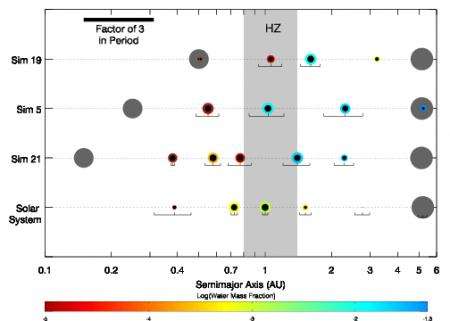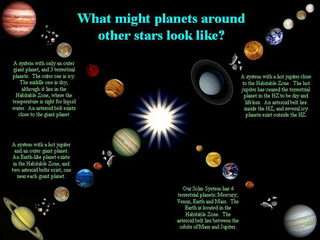March 19, 2006 feature
'Hot Jupiter' Systems may Harbor Earth-like Planets

The catalogue of confirmed extrasolar planets ('exoplanets') is growing rapidly. There are currently approximately 133 known planetary systems, harboring a total of 156 exoplanets as of January 2006*. With regard to the search for life-sustaining worlds, however, the results have been disappointing. Most of the exoplanets identified so far are so-called "hot Jupiters", gas giants in a stable orbit very close to their star. Stellar systems with a hot Jupiter were once thought to be incapable of forming Earth-like planets, but suprising new evidence indicates otherwise.
A planetary system begins its life as a disk of gas and dust surrounding a newborn star. As dust particles rich in heavy elements meet in their orbits, they can stick together and form larger, rocky grains. Eventually the disk of gas gives rise to a swirling swarm of ‘planetary embryos’, rocky bodies a few hundred miles across. Far from the stately ballet that we see in our own, mature solar system, the embryos are constantly getting thrown into new orbits by close encounters with their siblings.
Hot Jupiters are thought to form in the earliest stages of this process, as the largest embryos begin to accumulate mass at a truly impressive rate. One or more may grow into a full-fledged gas giant, clearing the disk of all debris in a wide band around their orbit. Nearby particles and embryos are either sucked into the giant, captured as satellites (forming moons or rings), or flung into a new orbit. Often these planets migrate towards their parent star as they form, wreaking havoc in their wake. The disk is depleted of matter as they slowly spiral inwards, so planetary embryos inside the giant’s original orbit would appear to have a low chance of survival.

Click here for high resolution image.
Sean Raymond, at the University of Colorado’s Laboratory for Atmospheric and Space Physics, doesn’t agree. The gravitational interactions involved can be modeled, and Jupiter-sized planets can migrate to a close, stable orbit more quickly than one might think. If a hot Jupiter settles into its final home while the planetary embryos are forming, the inner disk might still contain enough gas and dust to form terrestrial planets even after being thinned out by the gas giant’s passage.
Raymond has been collaborating with Tom Quinn (University of Washington) and Jonathan Lunine (University of Arizona) on the problem of planet formation in hot Jupiter systems. Their approach is to track the evolution of these systems through N-body simulations of the gravitational interactions between planetary embryos. In one set of simulations, already published in the journal Icarus, 120 to 180 embryos are randomly distributed over a disk of radius 5 AU (roughly the radius of our own Jupiter's orbit). A ‘hot Jupiter’ (placed at a distance of 0.15, 0.25, or 0.5 AU from the star) forms the inner limit of the simulated disk, and in some simulations a Jupiter-sized planet is also placed at 5.2 AU. Because the particles are supposed to represent a planetary disk depleted by the hot Jupiter's migration, their total mass is actually rather low.
Each protoplanet is given an iron and water content according to its distance from the star, with a significant water content only occurring at distances greater than 2 AU (the “snow line”, beyond which solid ice can form in the disk). As the simulation progresses, gravitational interactions between the protoplanets allow the orbits to evolve naturally towards a final, stable state. On a close approach, protoplanets can accrete in an inelastic collision.
After a hundred million years or so, the planetesimals been reduced to a handful of Earth-like planets. Quite often, a planet with high water content forms in the habitable zone of the star (the region with surface temperatures that permit liquid water). If a gas giant forms early and migrates quickly, rocky and even watery worlds could well have formed in its aftermath.
One might argue that the effect of the gas giant's migration through the disk might be even more disruptive than we think—who's to say that it doesn't obliterate the disk entirely as it passes through? To answer this question, Raymond is currently collaborating with Avi Mandell and Steinn Sigurdsson (Penn State University) to improve the simulations. Not only has the number of embryos grown to about a thousand, but Raymond also follows their progress during a gas giant's migration towards the star. As one might expect, most of the planetary embryos are kicked into highly eccentric orbits by the gas giant as it passes through. Despite this disruptive influence, quite a lot of dust and gas is left over for planet formation. “As long as you include the effects of gas drag to recircularize the [planetesimal] orbits,” Raymond explains to PhysOrg.com, “you end up preserving about a third of the starting mass.”
They're getting some surprising results, too. They sometimes end up with a planet several times more massive than the Earth in an orbit very close to the star. According to Raymond, “In front of the giant planet, material piles up and forms a large, rocky planet very quickly. There isn't supposed to be that much mass within 0.1 AU of the star.” The detection of large, rocky planets in close orbits, where the disk was too thin for them have accreted locally, would therefore be quite a coup for the collaboration. In fact, just such a planet may have been detected (albeit weakly) last year by a team of researchers using Keck observatory's high-resolution spectrometer (Rivera et al., 2005).
Not only are hot Jupiters easily detected, their stellar systems would appear to be promising targets in the search for terrestrial exoplanets. In the future, Raymond plans to extend this technique to the study of planet formation around low-mass stars and binary stars.
Citations:
-- “The formation and habitability of terrestrial planets in the presence of close-in giant planets”, Raymond S., Quinn T., and Lunine J., 2005, Icarus, 177, 256
-- “A ~ 7.5 Earth-Mass Planet Orbiting the Nearby Star GJ 876”, Rivera et al., 2005, Astrophysical Journal, 634, 625
By Ben Mathiesen, Copyright 2006 PhysOrg.com
















